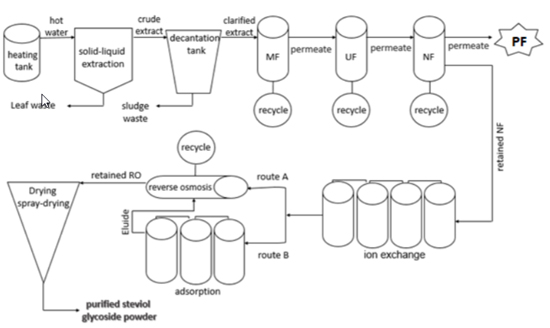'Natural' Sweetener Exhibits Numerous Stevia Dangers, Equal To or Even More Than Any Artificial Sweetener
Stevia dangers are rarely recognized. The US, EU countries, and many other governments have been certifying the use of stevia sweetener in various food items as an alternative to white sugar. It makes edibles, coffee, and soft drinks sweet without adding sugar. Various chemical examinations have been proving it without calories and ingredients, which can be considered harmful to human health.
The companies are promoting stevia additive edibles as naturally sweetened. The bloggers are creating hype about stevia leaves to generate more traffic and consequently sell stevia related products.
Does it all mean, stevia is safe for human consumption? Does it mean science has failed to find stevia dangers? Or it implies stevia dangers are not being promoted, intentionally or unintentionally for financial gains? The increasing popularity of stevia sweetner is not proof of its being without side effects.
The problem lies with the hazards that sugar is making with human health. Diabetes Type 2, obesity, and cardiovascular diseases have strong associations with the quantity of sugar being consumed by the patients. The underlying reasons for down scaling sugar consumption and more stevia sweetner shows consumers’ confidence in the advertisements, google, and social media content.
The promoters and lovers of the stevia sweetner have been claiming that stevia is a natural sweetener, so it does not cause those harms for which artificial sweeteners are commonly known. It doesn’t have mentionable calories, so it is helpful to reduce obesity. The stevia sweetner is indigestible in the body so useful to reduce diabetes levels. It doesn’t add anything in the blood, so harmful sugar effects do no reach our hearts. And in the process, it lowers the blood pressure too.
These claims need to be verified.
Does Being Natural Mean No Stevia Dangers?
It has been proved in various studies that artificial sweeteners are harmful to human health and cause various diseases. The promoters of stevia sweetener claim that it has been produced from a natural herb, so it is free from all side effects of sugar.
One significant objection to this hypothesis is that sugar is also produced from natural produces like sugarcane and beetle. If natural origin does not make sugar free from side effects, how can we whitewash stevia dangers just for its being natural? When we go through the process of purifying stevia, it becomes more evident that the claims of the stevia promoters seem misleading.
The latest method deployed by the Italian Association of Chemical Engineering describes the purification process of stevia sweetner in detail.
The process tells how stevia leaves are extracted with hot water having a temperature of at least 60-degree centigrade. The crude extract is taken to a tank to settle the impurities down.

“The permeated microfiltration material followed for ultrafiltration. In the nanofiltration, the permeated fraction (PF) was stored for further study, and the retained was sent to ion exchange membranes, percolating through the cation and anion columns, respectively. The ion exchange permeate can then follow two paths. The first is the reverse osmosis process for volume reduction and subsequent percolation in the adsorption column. The second is to follow directly from the ion exchange columns to the adsorption column.”
Then the purified extract is dried to obtain pure stevia sweetener. Some companies add other substances to increase the volume of sweetener so that it becomes easy to quantify different quantities for human consumption.
Australian Government's Rural Industries Research and Development Corporation has given this process to purify stevia sweetner and remove all stevia dangers:
• Soaking leaves in warm/hot water to dissolve the glycosides (in batches)
• Filtering the resultant liquid (often after adding a precipitation agent)
• Concentration by vacuum evaporation
• Resin exchange to separate the glycosides into high and low R-A fractions
• Ion exchange purification
• Evaporation and spray drying or, less frequently, crystallization to produce the stevia powder/crystals.
You can see the processing of purified stevia sweetner is similar to that of cane sugar and many other processed items. Sugarcane is crushed to extract the juice, which is filtered and then boiled to evaporate water. The remaining liquid is processed further into jaggery (Gur) and sugar.
Similarly, stevia may be processed further to separate high R-Afactions from converting Stevioside to Rebaudioside or some other glycoside to get rid of bitter stevia aftertaste.
This discussion leads us to another question while analyzing stevia dangers.
Is Stevia Sweetener a Drug or a Food?
Most of the plants and their parts are helpful for their nutritional and medicinal capabilities. Moringa oleifera is considered a miraculous tree for its chemical properties.
Most of the drugs are synthesized today. But many of them were originated from plants. Some of the critical drugs are plant extractions. A few of them are incredibly addictive.
Morphine, Codeine, Heroin
These all three drugs come from the opium poppy. The raw opium is obtained from poppies by slicing them a little while on plants. Heroin and morphine are extracted from the raw opium while passing them through various processes.
Alcohols
Most of the alcohols are derived from plants. What about grape wine? Tequila sugar is made through the fermentation process and is converted into alcohol.
Cocaine
Cocaine is derived from coca leaves that are commonly grown in South America. The coca leaves have to pass through various processes to convert into addictive cocaine. While coca leaves themselves have been used by the natives for centuries, without many severe addictive effects.
Methamphetamine
Methamphetamine is used as a recreational drug, a stimulant, a treatment for attention deficit hyperactivity disorder, and obesity. It is also called meth. It is derived from a little bush ma huang.
Aspirin
Willow bark is being used for centuries. Even Hippocrates is remembered to use it as a medicine around 300 B.C. A German company Bayer developed aspirin in 1897, and now various companies are selling their products with the same salt Salicylic acid found in willow trees.
Penicillin
Penicillin is considered one of the most important discoveries of medical science. It was discovered accidentally by Alexander Fleming in 1928 when blue-green penicillium grew over a petri dish filled with staph bacteria. Medicine was made out of Penicillium mold much later by Australian, German, and Britain scientists; Nobel laureates Howard Walter Florey and Ernst Chain, and Norman Heatley, respectively.
When we see that stevia sweetner is neither natural nor a food item, its sale and use as food supplement makes stevia dangers equal to any other drug or extract from plants. You may still ask, what are the stevia dangers after all?
Stay tuned!
Saqib Ali Ateel
Stevia Sweetener Getting Popular
Stevia Leads to Metabolic Syndrome
What are iron fortified foods?
What is your story of using Stevia sweetener?
Stevia is a natural, zero-calorie popular sweetener. You may disagree what is written above. It is comparatively a new switch from sugar. You are welcome with your point of view, your personal story of using it or even new research which refutes or alleviates moringa benefits. You are requested to share it with our visitors.
What's New?
-
What are iron fortified foods?
Iron fortified foods contain additional iron to help prevent deficiencies and support overall health, particularly in children and pregnant women. -
What are fortified foods?
What are fortified foods? How are they different from staple and common everyday foods? -
Baby Organic Food: “To be, or not to be, that is the question”
Baby organic food is free from insecticides, weedicides and residues of synthetic fertilizers thus much safer for babies

DOWNLOAD!



